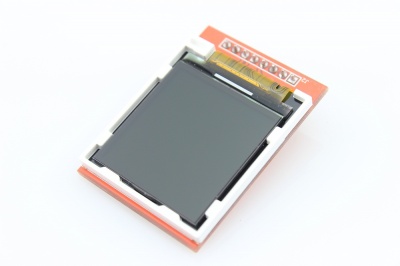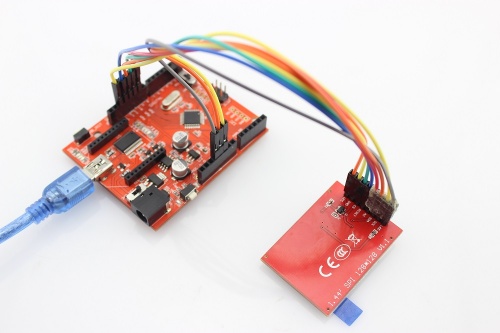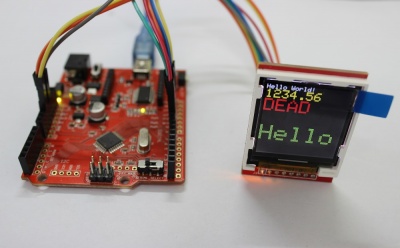1.44'' 128x128 TFT LCD with SPI Interface
Introduction¶
This Color TFT LCD display has 128 x 128 resolution and 262 color, it uses SPI interface to communicate with controller such Arduino, it is the best upgrading of the Nokia5110.
Model: DL144128TF
Features¶
- Size: 1.44 inch
- Interface:SPI
- Resolution: 128*128
- Visual area: 1:1 square
- TFT color screen, the effect is far better than other small CSTN screen
- Drive IC: ILI9163
- Fully compatible and alternative 5110 interface
- Onboard LDO, support 5V/3.3V input voltage, the LED backlight, 3.3V input
Usage¶
1.Hardware connection
2.Connect the board to PC using USB cable.
3.Download the library TFT_ILI9163C library;Unzip it into the libraries file of Arduino IDE by the path: ..\arduino-1.0.1\libraries.
4.Open the code directly by the path:File -> Example ->TFT_ILI9163C->test.
#include <SPI.h>
#include <Adafruit_GFX.h>
#include <TFT_ILI9163C.h>
// All wiring required, only 3 defines for hardware SPI on 328P
#define __DC 9
#define __CS 10
// MOSI --> (SDA) --> D11
#define __RST 12
// SCLK --> (SCK) --> D13
// Color definitions
#define BLACK 0x0000
#define BLUE 0x001F
#define RED 0xF800
#define GREEN 0x07E0
#define CYAN 0x07FF
#define MAGENTA 0xF81F
#define YELLOW 0xFFE0
#define WHITE 0xFFFF
TFT_ILI9163C tft = TFT_ILI9163C(__CS, __DC, __RST);
void setup() {
tft.begin();
}
void loop(){
testLines(random(0x00ff,0xffff));
delay(100);
testText();
delay(500);
}
unsigned long testText() {
tft.fillScreen();
unsigned long start = micros();
tft.setCursor(0, 0);
tft.setTextColor(WHITE);
tft.setTextSize(1);
tft.println("Hello World!");
tft.setTextColor(YELLOW);
tft.setTextSize(2);
tft.println(1234.56);
tft.setTextColor(RED);
tft.setTextSize(3);
tft.println(0xDEAD, HEX);
tft.println();
tft.setTextColor(GREEN);
tft.setTextSize(4);
tft.println("Hello");
return micros() - start;
}
unsigned long testLines(uint16_t color) {
tft.fillScreen();
unsigned long start, t;
int x1, y1, x2, y2,
w = tft.width(),
h = tft.height();
tft.fillScreen();
x1 = y1 = 0;
y2 = h - 1;
start = micros();
for(x2=0; x2<w; x2+=6) tft.drawLine(x1, y1, x2, y2, color);
x2 = w - 1;
for(y2=0; y2<h; y2+=6) tft.drawLine(x1, y1, x2, y2, color);
t = micros() - start; // fillScreen doesn't count against timing
tft.fillScreen();
x1 = w - 1;
y1 = 0;
y2 = h - 1;
start = micros();
for(x2=0; x2<w; x2+=6) tft.drawLine(x1, y1, x2, y2, color);
x2 = 0;
for(y2=0; y2<h; y2+=6) tft.drawLine(x1, y1, x2, y2, color);
t += micros() - start;
tft.fillScreen();
x1 = 0;
y1 = h - 1;
y2 = 0;
start = micros();
for(x2=0; x2<w; x2+=6) tft.drawLine(x1, y1, x2, y2, color);
x2 = w - 1;
for(y2=0; y2<h; y2+=6) tft.drawLine(x1, y1, x2, y2, color);
t += micros() - start;
tft.fillScreen();
x1 = w - 1;
y1 = h - 1;
y2 = 0;
start = micros();
for(x2=0; x2<w; x2+=6) tft.drawLine(x1, y1, x2, y2, color);
x2 = 0;
for(y2=0; y2<h; y2+=6) tft.drawLine(x1, y1, x2, y2, color);
return micros() - start;
}
5.Upload the Code,you shoule see the display of LCD.




